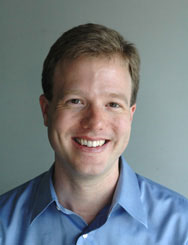Scott Manalis, Ph.D., a CSBC Investigator at the Massachusetts Institute of Technology (MIT), has always been interested in coming up with new types of measurements and ways to push the limits of quantitative approaches.
His enthusiasm for using a wide range of analytical skills to solve complex problems led him to study Physics at the University of California, Santa Barbara and Stanford University. As a graduate student, he designed state-of-the-art cantilevers for atomic force microscopes. He currently uses his knowledge of applied physics to develop microfluidic devices for systems biology studies.
In this interview, he discusses mentors and collaborators who have helped him in his career, as well as systems biology approaches to investigate cancer.
What advice would you give to trainees and young investigators?
Always stick to following the path that you’re most passionate about.
Who are some of your mentors that supported you through your career journey?
My Ph.D. thesis advisor, Cal Quate, who was an inventor of the atomic force microscope, provided me with valuable guidance and a great deal of freedom for exploring and following my passion.
For cancer systems biology research, Doug Lauffenburger, Marc Kirschner, and Tyler Jacks have all made important contributions to furthering my career at MIT. I’m incredibly grateful for their mentorship.
How do you define systems biology?
It is the idea of predicting how a complex system will behave.
What do you think the biggest challenges in cancer systems biology research will be in the next 10 years?
In my area of single cell analysis, emerging measurements are producing lots of information about the cell, at both the aggregate, biophysical level and the molecular level. I see two big challenges in this field:
- Understanding how to apply these measurements to the cells that matter most, which may be rare and/or might not have well defined markers.
- Turning single-cell data into a clear description of how the system will behave over time and in the presence of various perturbations.
Can you describe a quantitative technique that your lab has developed and its application to cancer systems biology research?
The Suspended Microchannel Resonator (SMR) can measure the mass of a single cell. This technology is 1-2 orders of magnitude more precise for measuring cell size than other methods, such as advanced forms of microscopy. By weighing the same cell multiple times, we can measure cell growth where growth is defined by the rate at which it accumulates biomass.
In our CSBC Research Center, we are integrating SMR growth measurements with single-cell RNA sequencing to inform our understanding of resistance mechanisms and guide personalized therapeutic strategies.
Why did you apply SMR technology to cancer research?
About a decade ago, we started working with Dr. Marc Kirschner at Harvard Medical School on using the SMR approach to understand how cell growth is related to progression through the cell cycle. We met at a poster session at Harvard Medical School, where my lab presented the SMR device.
Up until I met Marc, we would tell biologists that we could weigh a cell with incredible precision. They would respond, “that’s very cool – let us get back to you on what we could do with it.” However, Marc was one of the few who really did get back to us. He realized that the SMR could be used to answer important biological questions about the relationship between cell size and cell cycle activity. This established the foundation for on-going collaborations we’ve had over the past five years with physician scientists at Dana-Farber Cancer Institute.
Ultimately, we aim to address the question, “Can measuring ex vivo growth properties of a patient’s tumor cells help guide cancer treatment for that patient?” However, we have much to learn by first examining model systems, such as cell lines, patient derived xenografts and organoids.
How do collaborations contribute to cancer systems biology?
It’s exciting and rewarding to work with people that bring expertise to a problem that you don’t have. Combining two different sets of expertise to come up with an experiment neither side would’ve thought of is an incredibly fun process.
How does your CSBC-supported research help cancer patients?
Treatment for most cancers – particularly at relapse – is often selected empirically. This leads to situations where a patient receives a therapy that doesn’t work for him/her, when other cancer drugs would have been better.
If our CSBC program is successful, it will unveil new pathways to therapeutically target and will help us identify optimal treatments for individual cancer patients.
